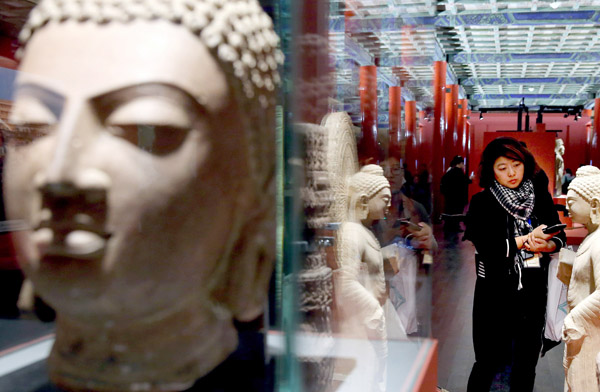 |
|
A total of 175 stone works from India and China are exhibited at the Palace Museum in Beijing. The exhibition runs through Jan 3.[Photo by JIANG DONG/CHINA DAILY]
|
Palace Museum series begins with stone works from Gupta era; Afghanistan, Russia to come
The Palace Museum is planning a series of exhibitions featuring ancient civilizations, the first being an ongoing display of sculptures from India's Gupta era - considered the "golden age" of Indian culture.
The recently opened Across the Silk Road: Gupta Sculptures and Their Chinese Counterparts, featuring artifacts from 400 to 700 AD, combines 175 fine rock works from the two countries. It runs through Jan 3.
This is the first time that 56 pieces of art from nine museums across India have been shown in China, said Prem Kumar Nagta, deputy director of the National Museum in New Delhi. The show highlights the evolution of religion, art and literature in India during the Gupta Empire - about 320 to 550 AD.
A sculpture of Ganesha, the Hindu deity with an elephant's head, from Gujarat province in western India, along with another Buddha head from Uttar Pradesh in the north, are among the key exhibits. The show also has relics from 25 museums in China, some outside of glass showcases to give visitors a closer look.
Chinese fine arts, especially Buddhism-themed stone carving, also flourished over roughly the same period - from the Northern Wei Dynasty (386-557) to the early Tang Dynasty (618-907) - according to exhibition curator Luo Wenhua, a researcher at the Palace Museum.
The Meridian Gate gallery, where the exhibition is being presented, was opened in 2015, aiming primarily for foreign exhibitions, said Shan Jixiang, the museum's director. All foreign exhibition slots are booked until 2019, he said.
The next foreign exhibition will be about ancient Afghanistan. It will consist of cultural relics that were secretly shipped overseas from that country amid rising fears of destruction by the Taliban, Shan said.
Researcher Luo said it took two years to organize the Indian Gupta exhibition, as there was little information available in China.
"The process helped us to create a foundation for academic studies and fill some voids in this area," Luo said.
The exhibition also marks a departure from the past for the museum, which earlier used administrative committees instead of individual scholars to drive such shows. Also, this show features greater depth. Many earlier exhibitions of foreign relics gave Chinese visitors only a general idea about cultures in other countries.
"People always want more stories surrounding relics. And stories can only be told better if there are more details on a focused topic," said Lou Wei, deputy director of the museum.
To illustrate this point, he cited the exhibition Faberge Revealed, a show that featured the belongings of Russian Tsars that was presented by the museum earlier this year, courtesy of the Virginia Museum of Fine Arts.
Two major principles are followed for exhibitions, Lou said. One is to cooperate with major world museums. The other is to display royal artifacts in an appropriately royal environment, such as the Palace Museum.
"We are also considering a third approach: to bring a series of exhibitions on the most brilliant early civilizations of the world," Lou said, adding that the current Gupta-era show is seen as the first installment.
By Wang Kaihao (China Daily)
Using WeChat? Scan QR Code or Press the Fingerprint Below ↓
--- (Or ADD WeChat ID: OKOKOKOKnet)
